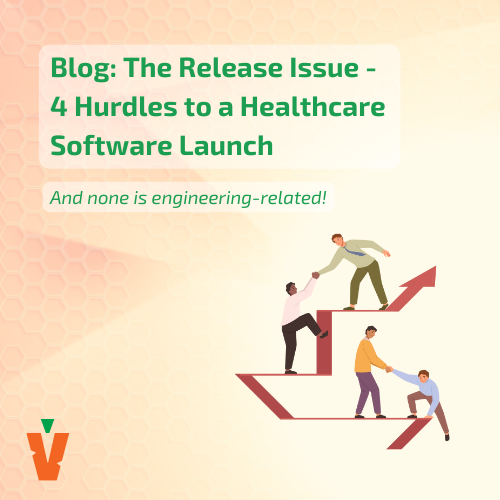Humans are bad at estimating the time they need to perform unfamiliar tasks — and healthcare software developers are no exception. So it’s no surprise that your team, despite its best efforts, sometimes end up looking like they just do the busy work. As a consequence, you have to appear once again before the board, investors, and other stakeholders, sharing the harsh truth about yet another delay.
What can you do about it?
Luckily, project delivery estimates aren’t a matter of sheer luck and a gut feeling. You can improve them with consulting past experiences, having well-defined procedures, and asking the right questions.
Reliability is a core value and mission at Vitamin Software, which includes delivering projects on an expected schedule. We’ve mastered this skill through years of trial and error, and today, we want to help you do the same (although more quickly and painlessly).
3 Obstacles in Healthcare Project Timelines
What can derail the software development timeline for a healthcare project? Our eight years in the industry helped us identify oft-occurring obstacles, which usually belong to three categories.1-
Underestimated Risks
Between the complexity of healthcare software development and the pressure to meet and exceed expectations, teams often promise the soonest possible project deadline. As a result, they ignore risks that could cause the timeline to take a detour.
In reality, not doing the prep work leads to more delays with greater severity (we’ve seen legal troubles causing company operations to delay a launch for up to a year). That’s why it’s the job of healthcare project management to reality-check plans, find potential problems, and devise ways to prevent them.
Consult your legal department about the latest laws and talk to cybersecurity to learn which protective measures to be introduced. Include the legal team early on, not only as a safety check a few weeks before the launch. Ensure your team understands everything they must do to enable seamless integration — like using the FHIR standard for data exchange. Eliminate scope creep by determining the deliverables before you launch development.
The point is — get your developers to list out the risks, and add wiggle room in your timeline for each.
Unforeseen Challenges
Unlike the previous healthcare software development issue, this one is hard to predict. It happens that, despite a plan, your job ends up more challenging than expected. For example:
- Moving away from legacy systems. The task of installing new software and decommissioning outdated systems can be more time-consuming than expected.
- Scalability issues. As the user base grows, scalability challenges can emerge. Then it’s on the developers to ensure the system handles increased user numbers without compromised performance.
- Negative user feedback. Unanticipated user resistance to certain features may introduce new software development tasks. This is easier to avoid if you involve the end-users early in the development cycle, but it still happens.
While you can’t solve these challenges proactively, you can foster open communication. Check in with the engineering and business teams, and keep everybody on the same page about your tasks and the time they may take. To do this, we at Vitamin send weekly executive reports to stakeholders — it’s a practice that pays off.
Planning Fallacy
The final obstacle comes from the way our brains work, but that doesn’t make it unsurmountable.
The planning fallacy is a cognitive bias that refers to humans’ tendency to underestimate the time, cost, and risks associated with future projects. It’s pretty much unavoidable but you can find ways to work around it.
As a healthcare project management leader, verify all plans before setting them in motion. It’s challenging to overcome how our brains work, but it makes us successful as PMs. Luckily, doing so can be as easy as asking our teams to attach proof to their narratives, because data beats the bias.
Which Factors Influence Project Time Estimates?
The scope is the main factor that determines a software development timeline — the more deliverables there are, the longer it takes. But the estimate isn’t always as simple as assigning a number to each task and summing them up.
1. Project Complexity
Project complexity determines the difficulty of your software development tasks. To determine it, consider the following questions:
- Do any tasks depend on other ones? In complex projects, some tasks may rely on finishing other ones first. For instance, if building EHR systems, the database must be complete before you create the UI. Interdependencies like this one increase the duration of tasks.
- Do you have enough internal resources? Some projects need skilled personnel, specialized tools, or advanced technologies. The availability of people and tools impacts the timeline, especially if allocating your workforce across several software development tasks. The Vitamin team can assist if you lack internal resources.
As complexity increases, so does uncertainty, coordination challenges, and the potential for unexpected issues. Consider these factors when assessing your software development timeline — it’s better to overestimate the duration than over-promise, hit a bump in the road, and fail to deliver.
2. Necessary Integrations
Healthcare project management includes more than handling engineers. Most software solutions for this industry require external APIs and connections with third parties, as interoperability is the standard of success. As a result, your timeline will depend on the availability and reliability of external integrations.
Integrations include EHRs, PMSs, clearinghouses, remote monitoring systems, and patient portals. Map them out in your plan, adjusting the project deadline accordingly.
Coordinating with third-party vendors could cause delays, so master the data requirements and formats to speed things along. The better your team meets external criteria, the more they’ll stick to the estimates. And this is a factor that gets better with feedback — we can bet that the third integration will be better-accounted for than the first.
3. Regulatory Obstacles
Compliance may require thorough documentation, so allocate enough time to prepare it. Integrate measures like cybersecurity and interoperability in your plan to know you’re not missing anything crucial at the launch date.
As a PM, check if everybody’s aware of compliance regulations. Talk to your cybersecurity and legal teams to set up requirements and educate your engineers to obey them to the T. Then, have them go back to the scope and check whether they’ve accounted for them.
4. Team Expertise
Knowing who’s on what task makes your healthcare software development estimates more reliable. It’s also a bargaining chip that lets you re-negotiate deadlines or ask for more hands on deck should you reach a roadblock.
The collective skill, knowledge, and experience of your engineers influence task duration and success. Be honest while determining the timeline based on the available staff — a team with strong technical skills and expertise in similar projects will reach the deadline earlier than a group of lower-level workers or those who haven’t cooperated before.
3 Questions to Ask Engineers to Verify Their Estimates
Having all software developed internally isn’t always possible; healthcare SaaS companies often rely on external vendors for some software development tasks. While you have less influence over a third-party team, showing them that you’re an educated client who knows what goes into a project deadline can encourage them to be honest about their capacities.
Here are three questions to ask third-party engineers to ensure their estimates are spot-on:
1. Have you talked with the partners involved in the integration process?
Integrating healthcare solutions requires effective communication with third-parties. By asking about these discussions, you beat the tendency to reduce risks to the punch. It’ll confirm if the engineers considered everything they must do for interoperability, which is a non-negotiable.
2. Can you provide a detailed itinerary and precise timelines for the PoC, MVP, release, and launch?
This question prompts the engineers to articulate their strategy and how they plan to move between project stages. It ensures there are no bottlenecks or unnecessary bench time, as it offers information about what you need to contribute for each phase. Another benefit is that it gives you enough time to check in with the stakeholders about the progress multiple times.
3. Have you documented all risks that could impact the software development timeline, and what measures are in place to mitigate or prevent these risks?
This question highlights the need for a risk management plan to reduce the risk of unexpected setbacks and maintain software stability before launch day. It also shows that you are ready to change the plan as needed, encouraging engineers to come to you if anything goes wrong.
The Vitamin Software Approach to Accurate Project Estimates
We at Vitamin pride ourselves on our timeliness and reliability. We can work fast when needed (for example, building a decision-support app that launched in 1500 pharmacies in one year). We’re also recognized for our ability to create tight business plans that work, like we did for Medicine Value Partners. Three factors contribute to our success:
- The Vitamin Sanity Check — our way of ensuring we’re accepting only viable, capital-efficient projects. We use this stage to analyze a client request, determine the features, timeline, and budget, and create a SoW. That way, every next step has much greater clarity.
- Weekly executive reports — we report to our stakeholders weekly to keep them on track with the project execution. That way, any delays and changed requirements are communicated in good time.
- Testing included in the product plan — we integrate our Q&A process in the plans presented to the client. That way, debugging is accounted for, and the final product is bug-free.
Key Takeaways on Spot-On Healthcare Project Timelines
Accurate healthcare software development timelines are crucial for successful and timely delivery. Even though it’s hard to establish a culture where you’re rarely over-promising, even if it causes disappointment among the C-suites, it’ll increase the level of trust and reliability in your company. And in the end, that’s a much greater benefit.
Here are key takeaways on achieving precision in project timelines:
- Begin by breaking down the project into specific tasks and subtasks. This granular approach gives you a detailed understanding of the project scope.
- Leverage historical data from similar healthcare projects. Analyzing past performance offers insights into expected timeframes and possible bottlenecks.
- Establish open communication channels with the development team. Regular check-ins and updates let developers provide real-time feedback on their progress.
- Identify potential risks and delays in the project timeline. Develop contingency plans to address these scenarios.
Want to make sure you avoid wasting hundreds of thousands of dollars in time and resources, and millions in launch delays? Schedule a consultation and let our Business Analyst poke holes in it until it’s as tight as possible.
.png)


.png)
